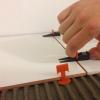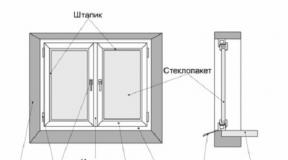BPH of the prostate - what is it, symptoms, diagnosis and treatment methods. Prostatic hyperplasia: causes, symptoms and treatment Moderate prostatic hyperplasia
Among prostate diseases, BPH is far from the last place, and after 40 years the risk of developing this pathology only increases. What is prostate BPH and why does it occur? This, as well as the methods of treating the disease and measures of its prevention, will be discussed in the article.
BPH is an abbreviation for benign prostatic hyperplasia, better known as prostate adenoma. This is a condition in which small formations (nodules) are formed in the prostate, gradually increasing in size. Their pathological proliferation leads to compression of the urinary tract, which is manifested by serious disturbances in the work of the urinary system.
The disease is benign, that is, it does not give metastases, although under the influence of a number of factors it can turn into prostate cancer. But even if this does not happen, the presence of a tumor in the gland negatively affects men's health and the entire body as a whole, significantly reducing the quality of life. BPH is rare in young men, but after 50-60 years, it is diagnosed in every third case. By the age of eighty, the risk of developing the disease increases to 70%.

The prostate gland consists of three types of tissues - muscle, glandular and connective, and any of them can be involved in the pathological process. Usually, the lesion is located in the central part of the organ and affects the lateral lobes, in some cases it can shift to one side or the other. The proliferation of tissues most often occurs in one direction, as a result of which three forms of pathology are distinguished.
Table. Forms of BPH by type of growth
| Pathology form | Main characteristics |
|---|---|
| Subbubble | It is considered the most common. Tissues grow in the direction of a straight line intestines, as a result of which the motility of the prostatic part of the urethra deteriorates, and urine does not come out completely. This form does not greatly affect the process of urination itself. |
| Intravesical | The tissue grows towards the bladder. The tumor through the urethra blocks the lumen of the bladder, compresses the internal sphincter and partially or completely disrupts its work. |
| Retrotrigonal | It is rarely observed. A tumor forms between the internal outlet of the urethra and the orifices of the ureters. The most severe form, characterized by a simultaneous deterioration in the outflow of urine and difficulty in its passage by the mouths. |
The focus of the disease is often single, although multiple are not so rare. Depending on this, the manifestations of pathology also change. The size of the tumor in the most advanced cases can exceed 80 mm in diameter, but usually varies between 10-40 mm.

The development of BPH occurs in stages, and experts distinguish three stages of pathology:
- compensated- early stage, developing over 1-3 years. It is characterized by mild urination disorders, a slight enlargement of the gland, a change in its density;
- subcompensated- disturbances in the work of the urinary system are more pronounced, the bladder is not completely emptied, there is a thickening of its walls. The gland itself increases by 1.5 times, its tissues become much denser;
- decompensated- the most severe stage with pronounced disorders in the work of the bladder. Many men have renal failure with typical manifestations.

Each stage has its own characteristic manifestations and, accordingly, requires different methods of treatment.
Causes and symptoms of BPH
The main cause of the pathology is considered to be hormonal changes in the male body, in which the balance of testosterone and estrogen is disturbed. This leads to uncontrolled growth of prostate cells, as a result of which it develops. Among the risk factors, the main one is the natural extinction of sexual functions, which begins at about the age of 50.

Less often, the development of BPHZ occurs for other reasons:
- Availability chronic diseases urogenital area;
- infectious lesions urinary tract;
- trauma;
- the presence of oncological tumors and metastases.

At an early stage, only a specialist can determine the development of adenoma, because the first symptoms are weak and similar to the manifestations of other prostate diseases. Later, when nodules begin to form in the tissues of the gland, general signs appear, which are already a reason to consult a doctor:
- the urge to urinate occurs more often, especially at night, while the urine stream is noticeably weaker than before;
- control over urination worsens, incontinence may occur;
- periodically occurs general weakness and apathy, weight loss;
- constipation is more common;
- erection decreases.

With the development of BPH, the symptoms worsen, pain syndrome arises, the nature and severity of which depends on the form of the tumor, the stage of the disease and the presence of concomitant pathologies in the body. Often, the disease is accompanied by formation in the prostate, which greatly complicates the treatment process. In patients with advanced BPH, the urine is cloudy, often mixed with blood, and is excreted in small portions.
Diagnostic methods
On the basis of these symptoms, it is impossible to diagnose yourself and select a treatment on your own, because this can lead to the most serious consequences. A urologist specializes in the treatment of BPH, and he also prescribes all the studies necessary for making a diagnosis. To accurately determine the presence of a tumor, its location, size, possible complications, several methods of complex diagnostics are used at once.
Table. Diagnostic methods for BPH
| Research method | Specifications |
|---|---|
| With the help of a digital examination, the specialist determines the presence of seals in the prostate, its size, and soreness. Additionally, this allows you to take for analysis the secret of the gland, which is released when massaging the lobules. | |
| The use of an ultrasonic sensor allows you to obtain an accurate image of a diseased organ and determine the size of the nodules, the localization of the tumor focus, and the presence of calculi in the gland. | |
| This method helps to accurately assess the state of the genitourinary system, identify possible complications in the form of stones in the bladder and kidneys, the formation of diverticula, and so on. The study can be carried out both with the use of contrast, and without it. | |
| Necessarily includes a biochemical and general blood test, urinalysis, if necessary, a prostate secret or a smear is examined (if an infection is suspected). | |
| Non-invasive method for assessing the state of the urethra. It is performed during urination and consists in measuring the flow rate and some other parameters. |
If you suspect a malignant nature of the disease, the doctor prescribes a biopsy. In some cases, MRI of the pelvic organs may be additionally prescribed, especially if the disease is advanced and accompanied by severe impairments in the work of the kidneys.

BPH treatment
In modern medicine for the treatment of BPH, several methods are used with high efficiency... The choice of the optimal method of treatment depends, first of all, on the stage and form of the disease, as well as on the presence of complications and the general condition of the body.
Drug therapy
In the first stage of BPH, drugs are not always prescribed, since therapeutic exercises and diet are usually enough to normalize the functioning of the genitourinary system. If necessary, your doctor may prescribe 5 alpha-reductase inhibitors, which inhibit tumor growth in the prostate. The most effective drugs in this group are: "Avodart", "Penester", "Urofin".

For the second stage, taking medications is the main type of therapy, since it allows you to eliminate pain manifestations, normalize the outflow of urine, and slow down the growth of nodules. In addition to alpha-reductase inhibitors, the patient is also shown herbal preparations that have an antispasmodic effect. The most famous of them are “Omnik”, “Kornam”, “Kardura”, pumpkin and chamomile extracts.

"Omnik": instructions for use
In the third stage, medications are prescribed as adjunctive therapy before and after the operation. The type of drugs is selected exclusively by a specialist, depending on the condition of the prostate and urinary system itself.

Tablets "Kardura"
Non-operative methods
The list of conservative treatment methods includes:
- ultrasound therapy;
- implantation of special dilating stents into the urethra;
- cryotherapy;
- radiofrequency treatment with the introduction of special needles through the urethra.

In addition to these procedures great importance It has physiotherapy(especially at an early stage of the disease), which improves blood circulation in the affected tissues, outflow of fluid, elimination stagnation in the gland. The set of exercises is also selected by the doctor, and they must be performed regularly for a long time.

Operative treatment
Surgical intervention is also carried out in different ways. In severe advanced cases, open surgery is performed to remove the tumor. If the formations are not too large and there are no complications, minimally invasive methods are used, for example, laser vaporization. After surgical treatment, the patient is placed in a catheter for urine diversion, drug therapy and diet are prescribed.

Prevention of BPH
Disease prevention plays an important role, which has already been proven by many years of research in urology. Preventing the development of BPH is not so difficult if you adhere to the following rules:
- adhere to a healthy lifestyle;
- if possible, give up alcohol abuse and smoking;
- pay more attention to physical activity;
- timely address problems in the genitourinary sphere to the doctor, do not start the disease;
- regularly undergo examination by a urologist after 40 years.

But the most important thing is not to engage in self-diagnosis and self-medication, because in most cases this leads to a deterioration in well-being, development side complications and a decrease in the chances of a full recovery of male health.
Video - BPH of the prostate gland: what is it, causes, treatment and prevention
Subject to the timely detection of BPH and a competent approach to treatment, the prognosis of this disease is usually favorable. But delaying a visit to a doctor can lead to the development of a malignant form of a tumor, which is much more difficult to cure. How prostate cancer manifests itself and how effective its treatment is, you can read.
Prostate adenoma is insidious in that the tumor can grow for a long time, sometimes 10 years, unnoticed for a person, slowly worsening the quality of life, in particular, making it difficult to urinate. Shame, laziness, lack of knowledge, or just a frivolous attitude towards gradual deterioration in the process of urination lead to the fact that a man postpones the diagnosis and treatment of prostate adenoma for a long time. As a result, the probability increases be on the operating table or become disabled and in the absence of the possibility of getting an ambulance medical care, even die as a result of acute urinary retention.
biophysicist, full member of the Academy of Medical and Technical Sciences V.A. Fedorov
Adenoma of the prostate is benign a tumor of the prostate gland or, scientifically, benign prostatic hyperplasia (abbreviated as BPH). The disease begins to be detected in 20% of men under 40 years old, at the age of 50-60 years - in 40%, at the age of 61-70 - in 70% of men, and after 70 years - in 80% (Berry, 1994).
It should be immediately clarified that a benign prostate tumor cannot degenerate into a malignant, that is, cancer as they grow from different parts of the prostate gland. Adenoma is the proliferation of small periurethral (submucous) glands in the central zone surrounding the urethra, and prostate cancer develops from large glands located on the periphery, far from the center.
Symptoms of Urinary Disorder
Although the disease is called "benign", it manifests itself as a significant deterioration in the quality of life:
- there is a need to urinate at night, and more than once, which leads to sleep disturbance and general fatigue;
- increased frequency of urination during the day (normal frequency is no more than every 2 hours during the day);
- no feeling of complete emptying of the bladder;
- Difficulty urinating: you need to make extra efforts, urinate in several stages;
- sharp and uncontrollable urge to urinate.
 Difficulty urinating is caused by the fact that the tumor, and to a greater extent severe swelling developing in the prostate (especially with grade 1 and 2 BPH), squeeze the urethra. At the same time, the efforts being made to "push" urine are not enough to completely empty the bladder. Residual urine in the bladder causes repeated frequent urge to empty. This explains the increased frequency of urination, both day and night. Pain when urinating not typical.
Difficulty urinating is caused by the fact that the tumor, and to a greater extent severe swelling developing in the prostate (especially with grade 1 and 2 BPH), squeeze the urethra. At the same time, the efforts being made to "push" urine are not enough to completely empty the bladder. Residual urine in the bladder causes repeated frequent urge to empty. This explains the increased frequency of urination, both day and night. Pain when urinating not typical.
The brightness of the manifestation of the above symptoms does not depend on the size of the tumor itself (it can be large, and the quality of life does not decrease significantly). This is often related to the direction of tumor growth. In this regard, it is very important for men after 40 to regularly visit a urologist, especially in case of changes in the process of urination and carry out preventive measures(for example, ). In the early stages of BPH, the likelihood of a positive result from conservative treatment is still high. without surgery.
There are 3 stages of BPH:
|
Symptoms and Signs |
|
|---|---|
|
Stage 1 (compensated) |
The muscle tone of the bladder is still sufficient to push urine through the narrowed canal, but efforts have to be made. There is no residual urine. Patients may notice:
This stage can be quite long: 10 years or more and depends on the initial state of the organism. |
|
(subcompensated) |
At this stage:
|
|
(decompensated) |
The resources of the muscular wall of the bladder are completely depleted, the bladder is like a stretched bag of urine that is squeezed out only drop by drop. At this stage, such dangerous complications as chronic renal failure, urolithiasis, etc. are almost inevitably detected. The likelihood of acute urinary retention is high. In the absence of medical care, the patient may die. |
Also used international classification with an IPSS * rating:

1. Minor stage - 0-7 points.
2. Moderate stage - 8-19 points.
3. Expressed stage - 20-35 points.
* IPSS (International Prostate Symptom Score) is an international system for the total assessment of prostate diseases ().
You can send a completed application form to the address for consultation on the possibility of using in your case a non-surgical method for the treatment of prostate adenoma and the selection of the device.
An important condition for effective treatment of prostate adenoma
Under effective and gentle treatment adenoma of the prostate is understood as the removal of edema in the area of the tumor, slowing down and stopping the growth of the tumor, as a result of which urination is restored and the quality of life improves.
Reducing the frequency of urination and increasing the flow is achieved, first of all, due to relieve swelling in this area. If the problem of urination was caused only by a tumor, then no amount of drug therapy and physical therapy () would ever improve urination without surgery. but treatment without surgery is possible!
Edema is, as a rule, the body's reaction to an excess of dead cells in this area. Obviously, dead cells begin to accumulate for 2 main reasons:
- The nutrition and protection of each cell deteriorates, they begin to die faster. With age, there are often problems with the blood supply to the pelvic organs, hormonal imbalance is observed (less and less hormones are produced that are necessary to maintain health and youth).
- The body does not have time to remove dead cells in a timely manner. Dead cells are excreted through the lymphatic vessels, however the available resources of the lymphatic system are no longer sufficient to utilize the increased number of dead cells and completely cleanse the tissues.
In addition, the remains of dead cells (especially their protein components) are "building blocks" for tumor growth. One of the reasons for the development of edema is the body's attempt to prevent the proliferation of tumor tissue, but thereby edema also leads to clamping of the urethra ("". Vasiliev AE, Kovelenov A.Yu., Ryabchuk FN, Fedorov VA. , 2004).
Output: important condition successful treatment adenomas - increased lymph flow(lymphatic drainage), which would cleanse the tissues from the excess of dead cells. This simultaneously solves two problems: removing edema in the prostate gland, slowing down and stopping tumor growth.
Treatment of prostate adenoma without surgery
Currently, medicine provides for conservative (non-surgical) treatment of prostate adenoma in 2 ways, as well as their combination.
1. Drug therapy
Drug treatment consists of taking:

The failure rate of drug therapy reaches 30%, and the effectiveness, respectively, is 70%.
The mechanism of action of drugs from each group is different: alpha-1-blockers help to facilitate the process of urination, and 5-alpha-reductase inhibitors help to inhibit tumor growth. The course of treatment lasts at least 6 months, usually a year or more, in order to obtain a pronounced effect. After a while, the symptoms of the disease may reappear, and then there is the need for a second course of treatment: this situation may persist until the end of the patient's life.
Possible individual intolerance to the components that make up the drugs. When accepting these funds, it is possible side effects, which is also associated with both the specificity of the mechanism of action of drugs, and with the characteristics of a particular organism. Medicines, in their essence, forcibly change the priorities of the body, leading to an additional load on the liver, kidneys, circulatory system, digestive system etc.
As indicated in Russian clinical guidelines with moderate and severe symptoms BPH (worsening urination) drugs are prescribed simultaneously from both groups. In this case, the minimum treatment budget is for a year can be about 15 600 rubles.
2. Vibroacoustic therapy (vibroacoustic therapy)
This physiotherapy treatment method does not have side effects, can afford avoid surgery and improve the patient's condition without drugs.
Vibroacoustic therapy can also be used in combination with drug therapy. Sound micro-vibration improves transport and metabolic processes in tissues, and, thereby, facilitates the delivery of the drug to the desired place, that is, increases the effectiveness of drug therapy.
However, in accordance with long-term observations, the use of only apparatus "Vitafon", as a rule, is sufficient to significantly improve the quality of life and remove edema.
 When it doesn't help conservative treatment(or drug therapy), surgery remains if general state the patient's health allows the operation. Sometimes in elderly people surgery impossible due to the presence of severe concomitant diseases, repeated myocardial infarctions, heart failure, strokes, etc. In this case, as indicated in, is indicated. This type of physiotherapy, in any case, will create conditions so that the process of urination does not deteriorate further.
When it doesn't help conservative treatment(or drug therapy), surgery remains if general state the patient's health allows the operation. Sometimes in elderly people surgery impossible due to the presence of severe concomitant diseases, repeated myocardial infarctions, heart failure, strokes, etc. In this case, as indicated in, is indicated. This type of physiotherapy, in any case, will create conditions so that the process of urination does not deteriorate further.
The operation is indicated in the following cases:
- Stage 3 prostate adenoma, when the patient is unable to urinate on his own due to atony (weakened and stretched bladder muscles).
- Patients with a pronounced decrease in the quality of life (regardless of the size of the tumor), assessed by the IPSS scale - 20–35 points.
- Patients in whom the first manifestation of the disease was acute urinary retention in 60% of cases are forced to operate within a year after the detection of BPH.

At the moment, preference is given to this type of operation as transurethral resection(TUR), when a special resectoscope device is inserted through the urethra and the tumor is removed without incision of the bladder. Another type of surgery without a bladder incision is laser vaporization when a special device is inserted into the urethra and the laser "evaporates" the tumor layer by layer. With both TURP and laser vaporization, there is a risk that some part of the tumor will not be removed: in this case, a relapse is possible and then a second operation can be prescribed.
If the tumor is large, adenectomy(abdominal surgery), when an incision is made in the anterior abdominal wall (or access is through the perineum), the bladder is opened and the tumor is removed.
Despite the fact that the tumor itself is removed during the operation, the patient's quality of life may remain unsatisfactory. Often persists increased urination, incontinence, residual urine(according to statistics, in 10% of patients), as well as complications and consequences may occur:
- bleeding;
- accession of infection;
- inability to urinate independently and life-long use of a catheter;
- retrograde ejaculation (semen is thrown into the bladder during intercourse)
- impotence;
- sclerosis of the bladder neck;
- Narrowing of the lumen of the urethra (stricture).
To speed up the healing process, to reduce the risk of complications after the operation, both at the stage of preparation for the operation and at the stage of rehabilitation, vibroacoustic therapy is recommended. As shown, the use of vibroacoustic therapy with the Vitafon apparatus after the TUR allows reduce the frequency of urination, completely get rid of residual urine, reduce the size of the prostate gland by relieving postoperative edema. Vibroacoustic therapy was originally used in traumatology and the treatment of postoperative sutures and has shown its high efficiency in accelerating healing.
Vibrating in this case is carried out by. The catheter is not an obstacle for vibroacoustic therapy.
Thus, the operation must be carried out strictly according to the indications of the doctor. If there are no obvious indications for surgery, microvibration makes sense, similar to biological microvibrations. For more than 25 years of use in more than 2 million people, not a single case of a negative side effect has been reported.
On the contrary, the expansion of the list of diseases that can be successfully treated with the "Vitafon" apparatus was due to the identification of side effects. positive effects:
The effectiveness of the treatment of these diseases has been confirmed, of which for more than 25 years, there are already over 100.
In addition to research, there is also medical practice, which also confirms the high effectiveness of the new method of physiotherapy, as evidenced by
In modern medicine, abbreviations are often used that are not entirely clear to an ordinary person without honey. education. One of these obscure abbreviations is BPH. What it is? Speaking in the language of doctors, it is - benign. But the people call it simpler - prostate adenoma (a variant of "prostate adenoma" is possible). Often, prostate adenoma is confused with a disease such as prostatitis. BPH is a benign formation, and it grows not without the participation of the stromal component of the prostate (in other words, the glandular epithelium), and prostatitis is nothing more than inflammation of the prostate gland. Do not confuse them.
BPH. What it is? Statistics
As mentioned above, BPH is a benign neoplasm. With it, in the prostate (the abbreviated name of the same one, small nodules are formed, which, as they grow, more and more squeeze the urethra.
Because of this, a man has urinary disorders. This disease has a benign growth, and this is what distinguishes BPH from cancer.
BPH is one of the most common diseases in urology today. According to statistics, it appears in almost 80 percent of men in old age. In 20 percent of cases, instead of BPH, the atrophy of the gland or its enlargement is observed.
BPH disease most often develops in men over 45 years of age.
More than half of men from 40 to 50 years old turn to a specialist with this ailment, and only in rare cases can the disease overtake young people.
Reasons for the development of BPH
To date, it is impossible to indicate the exact reasons for the development of BPH of the prostate gland, since they are simply not fully understood. It is believed that the disease is one of the signs of menopause in men.
The only risk factors are blood androgen levels and a person's age.

Usually, with age, a man gradually disrupts the balance between estrogens and androgens, which becomes the cause of a violation of control over the growth and function of gland cells.
It is known that there is no connection between BPH of the prostate and a person's sexual activity, orientation, bad habits, sexually transmitted diseases and inflammatory diseases, and none of the above does not affect the appearance of the disease.
Pathogenesis

BPH of the prostate gland most often appears in its central part, but sometimes it can also involve the lateral lobes. The growth of benign hyperplasia depends on the adenomatous growth (tumor) of the paraurethral glands. As a result, the gland's own tissue is displaced outward, and around the growing adenoma, a kind of capsule is formed from it.
Hyperplastic (i.e., tumor-affected) cells of the prostate tissue also tend to grow both towards the rectum and towards the bladder, and this is the reason for the upward displacement of the inner opening of the bladder and lengthening of the posterior part of the urethra.
There are several forms of hyperplasia according to the type of its growth:

Quite often, several forms of BPH can be seen in one person at the same time. This happens when the tumor grows in several directions at once.
BPH: symptoms
The signs of this disease directly depend on the location of the tumor, on its growth rate and size, as well as the degree of dysfunction of the bladder.
BPH of the prostate can be divided into three stages:

Diagnosis of the disease
The basis for the diagnosis is the characteristic complaints of men, for whom a special scale for assessing the symptoms of prostate adenoma (I-PSS) has been created. Basically, the diagnosis of BPH is made after a clinical examination of the patient, as well as such research methods:
- Palpation (digital) rectal examination of the prostate gland. Thanks to him, doctors have an idea of the consistency and size of the gland, the presence of a beard between its lobes, as well as the degree of painfulness to palpation.
- Laboratory tests of BPH. What it is? First of all, this is the familiar general urine test. Also carry out biochemical analysis blood, with the help of which the PSA level is determined (stands for prostate specific antigen).
- Instrumental methods. Most often it is cystoscopy and ureteroscopy. With their help, you can check the patency of the urethra, the condition of the lobes of the gland and. With these procedures, you can determine the volume of residual urine.
- Ultrasound procedure. It is also one of the types instrumental methods, allowing you to see the size of each lobe of the gland, its condition (the presence of stones, nodules). In addition to the usual ultrasound, it is also used
- X-ray research methods. Excretory urography (with contrast) and plain radiography (without contrast) can help determine the presence of complications of BPH for which treatment has been initiated. With the help of X-rays, stones in the bladder and kidneys are found.
BPH treatment

At the moment, there are many ways to treat the disease, each of which is highly effective on different stages BPH. The treatment of this ailment can be divided into three parts:
- Medication method of treatment
- Operative method of treatment
- Other non-operative methods of treatment
It is usually used at the first sign of BPH.
In the first stages of BPH of the prostate gland, treatment is aimed at reducing the growth rate of hyperplastic prostate tissue, improving blood circulation in nearby organs, reducing inflammation of the prostate gland and bladder, eliminating urinary stagnation, eliminating constipation, and facilitating urination.
It is also worth reducing fluid intake in the afternoon, especially before bed.
In the presence of clinical and laboratory signs of androgen deficiency, androgen replacement therapy is also prescribed.
Often, in parallel with the treatment of hyperplasia, treatment of its complications is carried out - cystitis, prostatitis or pyelonephritis.
Sometimes (against the background of hypothermia or alcohol consumption), the patient may develop.In this case, the patient needs to be urgently hospitalized and the bladder catheterized.
Let's take a closer look at each type of treatment.
Drug treatment
The two most commonly used treatments for BPH are drugs:
- Alpha-1 blockers (eg, tamsulosin, doxazosin, or terazosin). Their action is aimed at relaxing the smooth muscles of the prostate and bladder neck, which leads to an easier passage of urine. The effects of these drugs can be prolonged or short.
- Inhibitors (Permixon, Dutasteride, or Finasteride). These drugs prevent dihydrotestosterone (a biologically active form of testosterone) from being formed in the sick person's body, thereby shrinking the prostate gland.
Operative method of treatment
In severe cases, one drug treatment not to be dispensed with, and, as a rule, it is necessary to resort to surgical intervention. This can be excision of hyperplastic tissue (adenomectomy) or total resection of the prostate gland (prostatectomy).
There are two types of surgical intervention:
- Open surgery (transvesical adenomectomy)... With this intervention, access to the tissue of the gland is obtained through the wall of the bladder. This type is the most traumatic, and is used only in advanced cases. Open surgery provides complete cure for BPH.
- Minimally invasive surgery(in which there is practically no surgical intervention). They are performed using modern video endoscopic technology, without an incision. Access to the prostate through the urethra.
There is another type of surgical intervention that cannot be compared with those described above. Embolization of the arteries of the prostate is an operation performed by endovascular surgeons (described above by urologists) and consists in blocking the arteries of the prostate with small particles of a special medical polymer (through femoral artery). Hospitalization is not required, the operation is performed under local anesthesia and is not traumatic.
After any type of surgery, there is a small risk of complications such as impotence or urethral stricture.
Non-operative treatments
Non-operative methods of treatment include the following:
Cryodestruction;
Transurethral needle ablation;
Treatment with focused high-intensity ultrasound;
The method of microwave coagulation of the prostate or thermotherapy;
The introduction of prostatic stents in the area of narrowing;
Prostate.
Postoperative period
Alas, at some stages of the disease, an operation is simply necessary. BPH is a serious disease, and even after surgery, you need to follow some rules in order to finally get rid of the disease and not provoke a reappearance. The three main points that you must follow after surgery are a proper diet, a healthy lifestyle, and regular visits to the doctor.
Diet in postoperative period extremely important for the patient, as it can significantly contribute to the fastest recovery. The diet after surgery completely excludes fatty foods, spices, salty and spicy foods and, of course, alcohol. It is recommended to eat low-fat foods rich in fiber.
As for work, if your profession does not imply frequent physical work, then return to workplace can be done after a couple of weeks after the operation. For sedentary work, it is recommended to do a warm-up every half hour. A sedentary lifestyle can contribute to the stagnation of blood in the organs, from which the disease only exacerbates. For the first few days after your surgery, don't even think about lifting weights!
Give up smoking at least in the postoperative period (two weeks after surgery) if you cannot quit the addiction at all. Nicotine damages the walls of blood vessels, and this affects the blood circulation of the prostate, as a result of which an inflammatory process can occur.
Many people think that after the removal of BPH, it is worth forgetting about sexual activity forever. This opinion is erroneous, and a man's sexual function is fully restored after a while. However, sexual intercourse should be resumed no earlier than 4 weeks after the operation.
Another tip that you should pay attention to: you can get behind the wheel of a car no earlier than a month after the removal of BPH.
In general, the postoperative period lasts about a month, after which the patient can already return to his usual life. However, experts strongly recommend leading a healthy lifestyle in order to exclude the reappearance of the disease.
Urination after surgery
Almost immediately after the operation, the urine stream becomes stronger, and the emptying of the bladder is easier. After removing the catheter, you may feel pain during urination for some time, the reason for this is the passage of urine through the surgical wound.
Experts do not exclude the occurrence of urinary incontinence or urge to urinate in the postoperative period, these phenomena are completely normal. The more disturbed you are by the symptoms during the illness, the longer your recovery period will be. Over time, all problems will disappear and you will return to your normal rhythm of life.
For some time after the intervention, there may be blood clots in the urine. This phenomenon is associated with wound healing. It is recommended that you drink as much liquid as possible to properly flush your bladder. But in case of severe bleeding, you should immediately consult a specialist.
Forecasts
Prolonged urinary retention (in the event that treatment for prostate adenoma is not performed), in the end can lead to urolithiasis, in which stones form in the bladder, and later an infection. In this case, the most serious complication that a patient can expect without proper treatment is pyelonephritis. This ailment further exacerbates kidney failure.

In addition, prostate adenoma can give rise to malignant growth - prostate cancer.
Forecasts with adequate and timely treatment of the disease are very favorable.
Disease prevention
The best prevention of BPH is regular monitoring by specialists and timely treatment of prostatitis.
You should also eat right (reduce the amount of fried, salty foods, as well as spicy, spicy and smoked foods), quit smoking and alcoholic beverages... In general, a healthy lifestyle significantly reduces the risk of BPH.
So now you know what BPH is. The signs of this disease, treatment, postoperative period and even prevention are described in detail above.
In any case, this knowledge will be useful to you. Be healthy!
Content
In a hospital setting, according to severe symptoms and after a detailed diagnosis, the attending physician can reliably determine BPH of the prostate gland - what it is, and how to properly treat it will be determined on an individual basis. Inflammation of the prostate adenoma is prone to a chronic course with frequent relapses, fraught with dangerous complications, a decrease in sexual activity. Benign prostatic hyperplasia progresses in men over 40, so at this age it is advisable to think about reliable preventive measures in a timely manner.
What does BPH mean in urology
Every man should clearly understand what prostatic hyperplasia is, in order to exclude the development of such a dangerous ailment in the future. Structurally, these are pathogenic nodules formed in the prostate, which, as they grow, squeeze the urethra, while disrupting the process of natural excretion of the bladder. The characteristic neoplasm is benign in nature, but patients with such a diagnosis are at risk malignant tumors... Therefore, effective treatment for BPH must be timely.
Causes
Benign prostatic hyperplasia progresses exclusively in the male body, can become the main cause of sexual dysfunction, lack of ejaculation. It is very problematic to reliably determine the etiology of the pathological process, and many urologists call the appearance of BPH the first sign of an approaching "male menopause". Before you start taking medications, you need to consult a specialist for advice. Potential pathogenic factors of BPH and the formation of glandular hyperplasia are as follows:
- hereditary factor;
- environmental factor;
- the presence of bad habits;
- harmful production;
- carried over inflammatory processes prostate;
- venereal diseases;
- irregular sex life.
Forms
The process of proliferation of glandular tissue proceeds under the influence of sex hormones - testosterone and dihydrotestosterone. With their unstable concentration, problems with the urethra begin, benign tumor cells are formed, which multiply, increasing the characteristic neoplasm in size. It is important to know not only what BPH is, but also the classification of this disease to speed up the final diagnosis:
- Subcystic form of BPH, in which a benign tumor grows towards the rectum.
- Intravesical form of BPH, where the focus of pathology is limited mainly bladder, characterized by tumor growth.
- The retrotrigonal form of BPH with the localization of the pathological focus under the bladder triangle.
Stages
The diagnosis of BPH in urology has its own characteristics, which are due to the stage of the pathological process. To avoid prompt removal of prostate adenoma, it is required to respond in a timely manner to the first symptomatology of a characteristic ailment. Below are the stages of BPH that complicate the work of the prostate gland. So:
- The initial stage is compensation. The patient complains of palpable urinary retention, frequent urination especially at night. The duration of the period is up to 3 years, then the disease progresses.
- Average degree BPHD severity - subcompensation. The walls of the ureters are deformed under the influence of growing BPH, incomplete emptying of the bladder is observed, as a result of which an acute inflammatory process progresses.
- The severe stage of the disease is decompensation. The inflamed bladder stretches due to the accumulation of urine, hemorrhage, pyuria, symptoms of cachexia, dry mucous membranes, decreased hemoglobin (anemia), and constipation progress.
Symptoms of prostatic hyperplasia
Pathology almost immediately starts with pronounced symptoms, which eloquently indicate that not everything is in order with the patient's health. Palpation of the gland is accompanied by acute soreness, but the man pays more attention to urinary retention, which occurs in the active and resting stages. Other symptoms of inflammation are listed below:
- frequent urge to urinate;
- discharge of urine in intermittent jerks;
- delayed urination;
- tension when going to the toilet;
- growth of paraurethral glands;
- feeling of full bladder;
- soreness when urinating.
Clinical symptoms
The initial stage of BPH lasts from 1 to 3 years. At this time, the patient notices an increased urge to go to the toilet, which is accompanied by a weak stream of urine, a feeling of an empty bladder, and bouts of pain when the biological fluid exits. After urinating, there is internal discomfort, and you may want to go to the toilet after 20 minutes.
The middle stage of BPH is accompanied by a change appearance and the size of the prostate, organ soreness on palpation. Urine is excreted in small portions, while incontinence is possible. Going to the toilet is accompanied by acute attacks of pain, there are unpleasant sensations during bowel movements. It is difficult not to notice such symptoms, therefore the patient's task is to consult a urologist.
The third stage of BPH is complicated. A stream of urine in an insignificant amount is released from the urethra, the appearance of impurities of blood and mucus in this biological fluid is possible. At this stage, a sharp decrease in kidney function prevails, since the pelvis does not excrete fluid in the required volume, renal failure progresses.
Echoes of BPH
By the symptoms of BPH, the prostate resembles urolithiasis, but doctors distinguish distinctive features characteristic ailment. Echoes of prostatic dysplasia are determined by the growth rate of the glandular tissue, the size of the lumen of the urinary tract. The presence of diffuse structural changes in the prostate gland indicates the course of the pathology, potential complications of BPH.

BPH treatment
Before proceeding to intensive care, it is required to undergo diagnostics, which, in case of inflammation of the prostate gland, includes transrectal ultrasound to measure the prostate and identify the features of its structure, cystoscopy for internal examination of the bladder and urethra, uroflowmetry in the form of performing a series of tests. Using the transrectal method, it is possible to record the volume of the inflamed prostate gland with maximum accuracy and finally determine the diagnosis. General recommendations a doctor for BPH are presented below:
- On initial stage it is required to restore systemic circulation, medication to ensure the natural outflow of urine. Additionally, give up bad habits, eat right and lead an active lifestyle.
- In the second stage clinical picture complicated, surgical treatment may be required. If the doctor suspects obstruction of the urethra, it is impossible to do without an operation followed by a rehabilitation period.
- The third stage of BPH of the prostate gland is complicated, it is treated only with radical methods. Conservative therapy ineffective. The recommended resection of the prostate gland requires a long rehabilitation period.
Medication
If the prostate gland is inflamed and sore, you need to see a urologist. After studying the patient's complaints and instrumental diagnostics, the specialist recommends sparing conservative methods with a stable therapeutic effect... More often, doctors prescribe representatives of the following pharmacological groups:
- 5-alpha-reductase blockers recommended for patients with an enlarged prostate volume of more than 40 ml: Finasteride, Proscar, Dutasteride, Avodart;
- alpha-blockers to reduce the severity of anxiety symptoms, acute pain syndrome: Terazosin, Doxazosin, Tamsulosin;
- phosphodiesterase inhibitors effectively remove the symptoms of erectile dysfunction: Tadalafil, Cialis.
Surgical
If the third stage of BPH of the prostate is diagnosed - what is it, is determined by a detailed diagnosis. Effective treatment carried out exclusively by surgical methods, the main purpose of which is the surgical removal of the adenoma, excision of the affected tissues involved in the pathological process. Here are the operations that urologists prescribe in the hospital:
- Removal of BPH by the transurethral method involves instrumental excision of the prostate tissue located along the urethra and squeezing its lumen.
- Adenomectomy. The operation is performed under general anesthesia with a large prostate, it is accompanied by a long rehabilitation period.
- Prostatectomy. Partial excision of the affected tissue with a minimum of side effects.
- Laser ablation provides compression of the urethra due to the high temperature and further "shrinking" of the prostate tissue surrounding the urethra.
Non-operative treatments
Conservative, minimally invasive and alternative methods of intensive care are highly effective only for early stage BPH of the prostate - what it is and how to act, the urologist will tell you in more detail after the examination. Here are the most popular treatments:
- cryodestruction;
- thermotherapy;
- transurethral needle ablation;
- the introduction of prostatic stents into the area of narrowing;
- balloon dilatation of the prostate.

RCHD (Republican Center for Healthcare Development of the Ministry of Health of the Republic of Kazakhstan)
Version: Clinical protocols MH RK - 2013
Hyperplasia of the prostate (N40)
Urology
general information
Short description
Approved by the minutes of the meeting
Expert Commission on the Development of Healthcare of the Ministry of Health of the Republic of Kazakhstan
No. 23 dated December 12, 2013
Benign prostatic hyperplasia(BPH) is a benign tumor that develops as a result of hyperplasia of predominantly glandular (epithelial) and less stromal cells of the prostate, against the background of a violation of the receptor apparatus of the prostate, interacting with testosterone metabolites, which leads to an increase in the mass of the organ, as well as a deterioration in the passage of urine from the bladder ( bladder outlet obstruction), due to compression of the posterior urethra (the prostate surrounds the urethra). The process has chronic course, as a result of which there is a decompensation of the contractile function of the bladder, an increase in residual urine, the formation of ureterohydronephrosis, the onset and progression of inflammatory diseases of the kidneys, bladder, renal failure... (Lopatkin N.A. 1998)
I. INTRODUCTORY PART
Full title: Benign prostatic hyperplasia
TOodprotocol:
ICD-10 code:
N40 - Prostatic hyperplasia
Abbreviations used in the protocol:
LHC-biochemical blood test
BPH- Benign Prostatic Hyperplasia
IVO - bladder outlet obstruction.
OAM general analysis urine
PSA-prostate-specific antigen
Ultrasound ultrasound
Protocol development date: April, 2013
Patient category: men aged 45 years or more, with complaints of difficulty urinating, who, according to ultrasound, have BPH
Protocol users: urologists, andrologists, surgeons
Classification
Clinical classification:
Stage 1 - the onset of urination disorder with complete emptying of the bladder,
Stage 2 - significant dysfunction of the bladder, the appearance of residual urine,
Stage 3 - the development of complete decompensation of the function of the bladder, the appearance of paradoxical ischuria. (Lopatkin N.A. 1998)
Diagnostics
II. METHODS, APPROACHES AND PROCEDURES OF DIAGNOSTICS AND TREATMENT
List of basic and additional diagnostic measures
Examinations required before planned hospitalization:
| Name | Multiplicity (shelf life of the result) |
| UAC | 1 (no more than 10 days) |
| OAM | 1 (no more than 10 days) |
| BAC (total protein, urea, creatinine, glucose, total bilirubin, direct blirubin, ALT, AST) | 1 (no more than 10 days) |
| ECG with conclusion | 1 (no more than 10 days) |
| Bacterial urine culture | 1 (no more than 10 days) |
| Coagulogram | 1 (no more than 10 days) |
| Microreaction | 1 (no more than 15 days) |
| Blood type and Rh factor | 1 (stamped and signed) |
| Fluorography | 1 (no more than 10 days) |
| HIV test | 1 (no more than 6 months) |
| Markers of hepatitis B and C | 1 (no more than 6 months) |
| Examination by a therapist, ENT doctor, dentist | 1 (no more than 10 days) |
| 1 (no more than 10 days) | |
| Excretory urography with descending cystography | 1 (no more than 2 months) |
| Name of service | The main | Additional |
| Complete blood count (6 parameters) | 1 (every 10 days) | |
| General urine analysis | 1 (every 10 days) | |
| BAC (with determination of urea, glucose, total and direct bilirubin, creatinine, ALT, AST) | 1 (every 10 days) | |
| Examination by an anesthesiologist | 1 | |
| Histological examination of tissue | 1 | |
| ECG | 1 | |
| Ultrasound of the urinary system | 1 | |
| Intravenous urography with descending cystography | 1 | |
| Computed tomography of the urinary system | 1 | |
| Determination of the total PSA level. | 1 | |
| Uroflowmetry | 1 | |
| Consultation of narrow specialists in the presence of pronounced concomitant diseases (cardiologist, endocrinologist, neurologist, etc.) | 1 |
Diagnostic criteria
Complaints and anamnesis: Complaints of difficulty urinating, frequent nocturnal urination, feeling of residual urine for a long time, or acute urinary retention resulting in catheterization or cystostomy.
Physical data: rectally, the prostate is enlarged, adenomatous, altered, of dense elastic consistency, also in the presence of a large volume of residual urine, palpation of the bladder in the suprapubic region palpates an overflowing bladder.
Laboratory research:
-
in OAM - leukocyturia, bacteriuria, hematuria are possible;
-
with prolonged IVO in the LHC, an increase in blood urea and creatinine is possible.
Instrumental data:
- according to ultrasound examination data: residual urine, echographic signs of BPH;
- by uroflowmetry: violation of the urodynamics of the lower urinary tract;
- X-ray cystography: filling defect along the lower contour of the bladder.
NSproviding specialist advice: taking into account the severity of concomitant diseases:
- for coronary pathology - cardiologist;
- with diabetes mellitus, an endocrinologist;
- for chronic renal failure - nephrologist;
- elevated PSA and hematuria-oncologist, etc.
Differential diagnosis
| Signs | Prostate cancer | BPH |
| Features of the anamnesis | Dysuria, terminal gross hematuria. weight loss, general malaise due to the paraneoplastic process. More often unilateral lymphatic edema due to lymphostasis. | Dysuria, residual urine nocturia, weakness, malaise due to the concomitant infectious process of the genitourinary system, symmetrical edema is possible due to exacerbations of chronic pyelonephritis. |
| Rectal prostate | Slightly increased in size or usual size of woody consistency (especially on the periphery), the contour is uneven, bumpy. | The prostate has a dense elastic consistency, adenomatous changes, enlarged, the contour is even |
| X-ray signs | Unilateral ureterohydronephrosis, due to germination of the ureteral orifice, uneven outline filling defect on the cystogram | Possible 2-sided ureterohydronephrosis due to compression of the ureteral orifices symptom of "fishhooks", an even filling defect along the lower contour on the cystogram |
| Computed tomography ultrasound | Signs of tumor growth outside the organ | A tumor of a smooth adenomatous structure does not go beyond the capsule |
| Prostate-specific antigen level | Increased, dramatically increased | Normal, slight increase due to adenomitis or after rectal examination |
| Prostate biopsy | Cancer cells of the prostate | BPH cells |
Treatment abroad
Undergo treatment in Korea, Israel, Germany, USA
Get advice on medical tourism
Treatment
Intactandtreatment:
Elimination of BPH as a cause of bladder outlet obstruction, drainage in order to unload the lower urinary tract. During the hospitalization of the patient, the amount of necessary follow-up examination is determined in order to determine the volume of BPH and concomitant pathology, which predetermines the volume and type of surgery, as well as measures of preoperative preparation and features. postoperative management sick.
Treatment tactics
Non-drug treatment: stationary mode, half-bed, table number 15.
Drug treatment with planned hospitalization:
1. Antibacterial therapy(3rd generation cephalosporins 1 g x 2 r / d i / m, amikacin 0.5 g x 2 r / d i / m, metronidazole 100 ml x 1-2 r / d / i / v, ciprofloxacin 100 ml x 1 -2 r / d i / v, levofloxacin 500 mg x 1 r / d i / v)
2. Hemostatic therapy (dicinone 2.0 x 2 r / d i / m, etamzilate 2.0 x 2 r / d i / m, tramin 10% 5 ml x 1-2 r / d i / v)
3. General strengthening therapy (glucose 5% 250 ml x 1 r / d i / v, vit. C 10.0 x 1 r / d i / v, vit. B1 1.0 x 1 r / d i / m, vit. B6 1.0 x 1 r / d i / v)
4. Metabolic drugs with an immunomodulatory effect: Vitaprost suppositories 1 time per day. 10 days
5. Analgesic therapy (ketoprofen 2.0 x 2 r / d i / m, promedol 2% 1.0 x 1 r / d i / m)
6. Antispasmodic therapy (drotaverin 2.0 x 2 r / d i / m)
7. Drugs that improve intestinal motility (metoclopramide 2.0 x 2 r / d i / m)
Other treatments: No
Surgery: Trocar cystostomy, transvesical adenomectomy, transurethral photoselective laser vaporization of BPH, transurethral plasma vaporization of BPH, transurethral microwave thermotherapy of BPH, mono- and bi-polar transurethral resection of BPH, transurethral resection of BPH, high epithelium resection of the urinary tract up to 80 grams)
Preventive actions:
- preparations of alpha 5 reductase inhibitors: dutasteride 500mcg x 1 r / d-3-6 months, finasteride 500mkg x 1 r / d-3-6 months, prostamol-uno 320mg x 1 r / d-3 months
- alpha adrenergic blockers: doxazosin 1 tab x 1 r / d and its form, tamsulosin 0.4 mg 1 capsule x 1 time per day and its form;
- metabolic therapy: vitaprost tablets 100mg x 2 times / day for 30 days;
- observation of a urologist, control of OAC, OAM, ultrasound of the kidneys, bladder, prostate, residual urine volume - after 1 month, if necessary, anti-inflammatory therapy, in order to sanitize chronic foci of urinary system infection.
Further management:
- within 1 month after surgery: do not take anti-coagulants, antiplatelet agents
- limitation physical activity
- blood pressure control (not higher than 140/90 mm Hg)
- do not take hot water treatments
- to carry out the prevention of intestinal constipation (do not strain during bowel movements).
Indicators of the effectiveness of treatment and the safety of diagnostic and treatment methods described in the protocol:
- decrease or absence of residual urine volume, free urination, light urine
- with adenomectomy - wound healing by primary intention, consistency of sutures, dry and clean postoperative wound
- in laboratory tests, the absence of high leukocytosis, leukocyturia is allowed, a moderate decrease in the levels of hemoglobin and erythrocytes.
Preparations ( active ingredients) used in the treatment
| Amikacin (Amikacin) |
| Ascorbic acid |
| Dextrose |
| Doxazosin (Doxazosin) |
| Drotaverinum (Drotaverinum) |
| Dutasteride |
| Ketoprofen (Ketoprofen) |
| Levofloxacin |
| Metoclopramide |
| Palm repens fructuum extract (Serenoa repens fructuum extract) |
| Pyridoxine |
| Prostate extract |
| Tamsulosin |
| Thiamin |
| Tranexamic acid |
| Trimeperidine |
| Finasteride |
| Ciprofloxacin (Ciprofloxacin) |
| Etamsylate |
Groups of drugs according to ATC used in treatment
Hospitalization
Indications for hospitalization (planned):
- Difficulty, frequent urination,
- nocturnal pollakiuria,
- residual urine,
- chronic urinary retention,
- the inability to urinate independently, with the presence of a cystostomy or urethral catheter.
Information
Sources and Literature
- Minutes of meetings of the Expert Commission on Healthcare Development of the Ministry of Health of the Republic of Kazakhstan, 2013
- 1. “2010 Update: Guidelines for the management of benign prostatic hyperplasia,” Canadian Prostate Health Council and Canadian Urological Association Guidelines Committee ‡; Can Urol Assoc J 2010; 4 (5): 310-316 2. Lopatkin N.A. Benign prostatic hyperplasia. - M., 1998.3 Gorilovsky L.M. Diseases of the prostate gland in old age. - M., 1999.4 Trapeznikova M.F. Classification of methods of treatment of benign prostatic hyperplasia - M., 1997.
Information
III. ORGANIZATIONAL ASPECTS OF THE PROTOCOL IMPLEMENTATION
List of protocol developers:
Alchinbaev M.K. - Doctor of Medical Sciences, Director of the Scientific Center of Urology named after V.I. academician B.U. Dzharbusynova
Reviewers:
Doctor of Medical Sciences, Professor Khairly G.Z.
No Conflict of Interest Statement: absent.
Indication of the conditions for revision of the protocol: Revision of the protocol 5 years after its entry into force and / or when new diagnostic methods / treatment with more high level evidence.
Attached files
Attention!
- Self-medication can cause irreparable harm to your health.
- The information posted on the MedElement website and in the mobile applications "MedElement", "Lekar Pro", "Dariger Pro", "Diseases: Therapist's Guide" cannot and should not replace an in-person consultation with a doctor. Be sure to contact medical institutions if you have any medical conditions or symptoms that bother you.
- Choice medicines and their dosage should be discussed with a specialist. Only a doctor can prescribe the right medicine and its dosage, taking into account the disease and the condition of the patient's body.
- MedElement website and mobile applications "MedElement", "Lekar Pro", "Dariger Pro", "Diseases: Therapist's Guide" are exclusively information and reference resources. The information posted on this site should not be used to unauthorized changes in the doctor's prescription.
- The editors of MedElement are not responsible for any damage to health or material damage resulting from the use of this site.



















